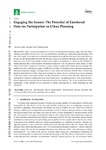Engaging the Senses: The Potential of Emotional Data for Participation in Urban Planning
| dc.contributor.author | Fathullah, A | |
| dc.contributor.author | Willis, K | |
| dc.date.accessioned | 2018-09-17T14:58:58Z | |
| dc.date.issued | 2018-09-21 | |
| dc.identifier.issn | 2413-8851 | |
| dc.identifier.issn | 2413-8851 | |
| dc.identifier.other | 98 | |
| dc.identifier.uri | http://hdl.handle.net/10026.1/12373 | |
| dc.description.abstract |
<jats:p>This paper presents an exploratory study on the potential for sharing urban data; one where citizens create their own data and use it to understand and influence urban planning decisions. The aim of the study is to explore new models of participation through the sharing of emotional data and focuses on the relationship between the physical space and emotions through identifying the links between stress levels and specific features of the urban environment. It addresses the problem in urban planning that, while people’s emotional connection with the physical urban setting is often valued, it is rarely recognised or used as a source of data to understand future decision making. The method involved participants using a (GSR) device linked to location data to measure participant’s emotional responses along a walking route in a city centre environment. Results show correlations between characteristics of the urban environment and stress levels, as well as how specific features of the city spaces create stress ‘peaks’. In the discussion we review how the data obtained could contribute to citizens creating their own information layer—an emotional layer—that could inform a shared approach to participation in urban planning decision-making. The future implications of the application of this method as an approach to public participation in urban planning are also considered.</jats:p> | |
| dc.format.extent | 0-0 | |
| dc.language | en | |
| dc.language.iso | en | |
| dc.publisher | MDPI AG | |
| dc.subject | emotions | |
| dc.subject | participation | |
| dc.subject | digital participation | |
| dc.subject | physiological sensors | |
| dc.subject | galvanic skin response | |
| dc.subject | GSR | |
| dc.subject | stress levels | |
| dc.subject | emotional layer | |
| dc.subject | urban | |
| dc.title | Engaging the Senses: The Potential of Emotional Data for Participation in Urban Planning | |
| dc.type | journal-article | |
| dc.type | Article | |
| plymouth.issue | 4 | |
| plymouth.volume | 2 | |
| plymouth.publication-status | Published online | |
| plymouth.journal | Urban Science | |
| dc.identifier.doi | 10.3390/urbansci2040098 | |
| plymouth.organisational-group | /Plymouth | |
| plymouth.organisational-group | /Plymouth/Admin Group - REF | |
| plymouth.organisational-group | /Plymouth/Admin Group - REF/REF Admin Group - FoAH | |
| plymouth.organisational-group | /Plymouth/Faculty of Arts, Humanities and Business | |
| plymouth.organisational-group | /Plymouth/Faculty of Arts, Humanities and Business/School of Art, Design and Architecture | |
| plymouth.organisational-group | /Plymouth/REF 2021 Researchers by UoA | |
| plymouth.organisational-group | /Plymouth/REF 2021 Researchers by UoA/UoA13 Architecture, Built Environment and Planning | |
| plymouth.organisational-group | /Plymouth/Users by role | |
| plymouth.organisational-group | /Plymouth/Users by role/Academics | |
| plymouth.organisational-group | /Plymouth/Users by role/Researchers in ResearchFish submission | |
| dcterms.dateAccepted | 2018-09-11 | |
| dc.rights.embargodate | 2018-10-9 | |
| dc.identifier.eissn | 2413-8851 | |
| dc.rights.embargoperiod | Not known | |
| rioxxterms.versionofrecord | 10.3390/urbansci2040098 | |
| rioxxterms.licenseref.uri | http://www.rioxx.net/licenses/all-rights-reserved | |
| rioxxterms.licenseref.startdate | 2018-09-21 | |
| rioxxterms.type | Journal Article/Review |


